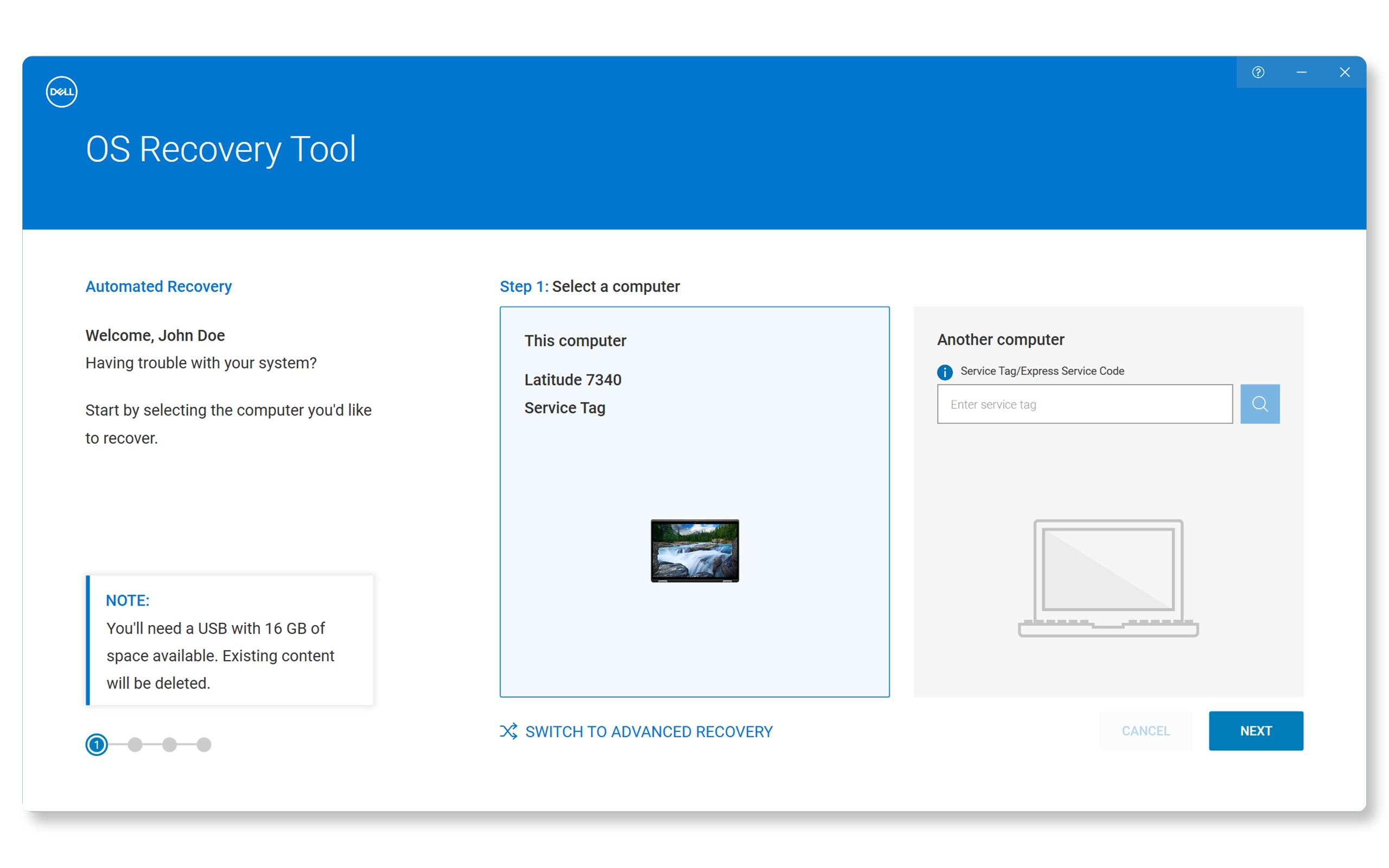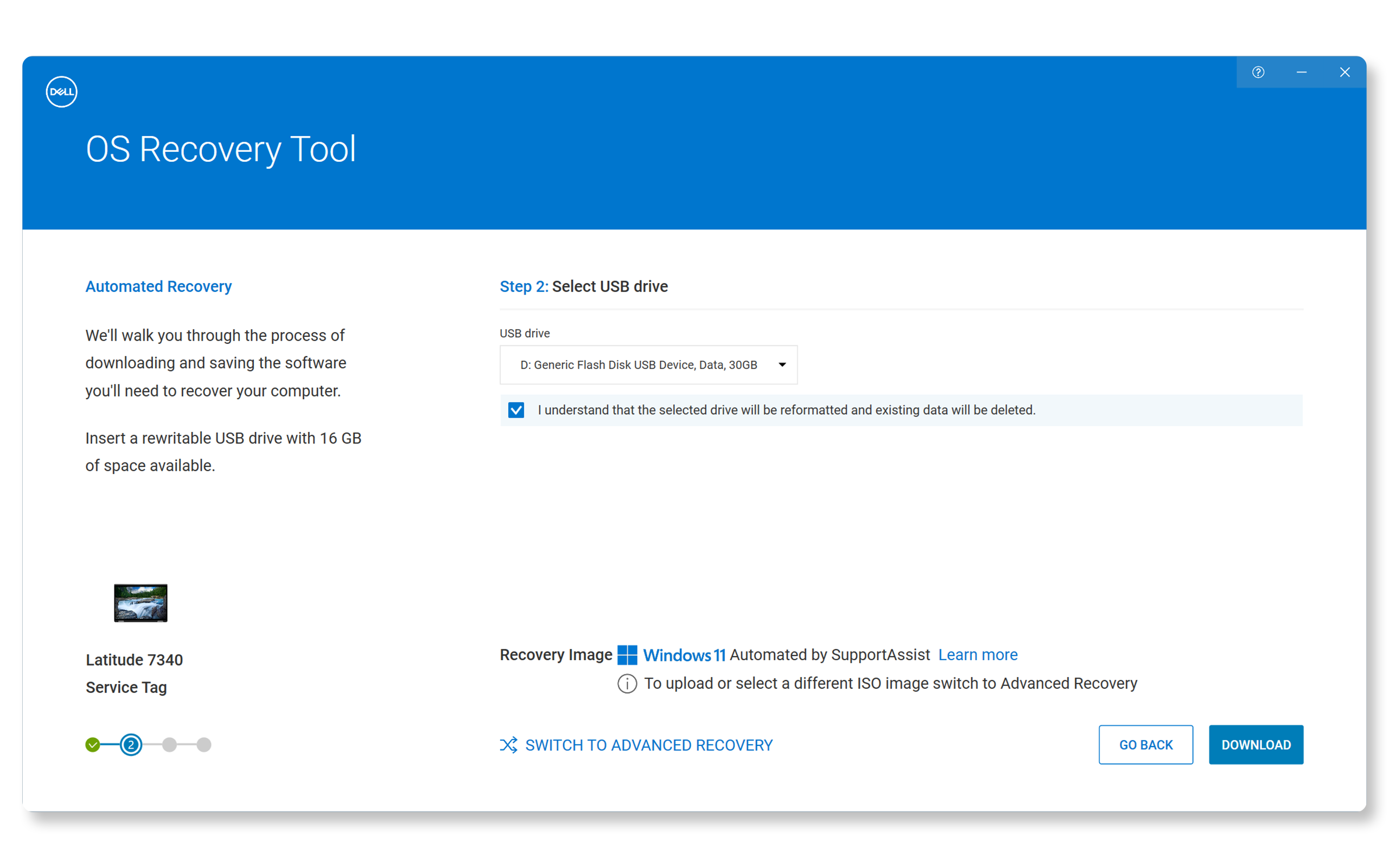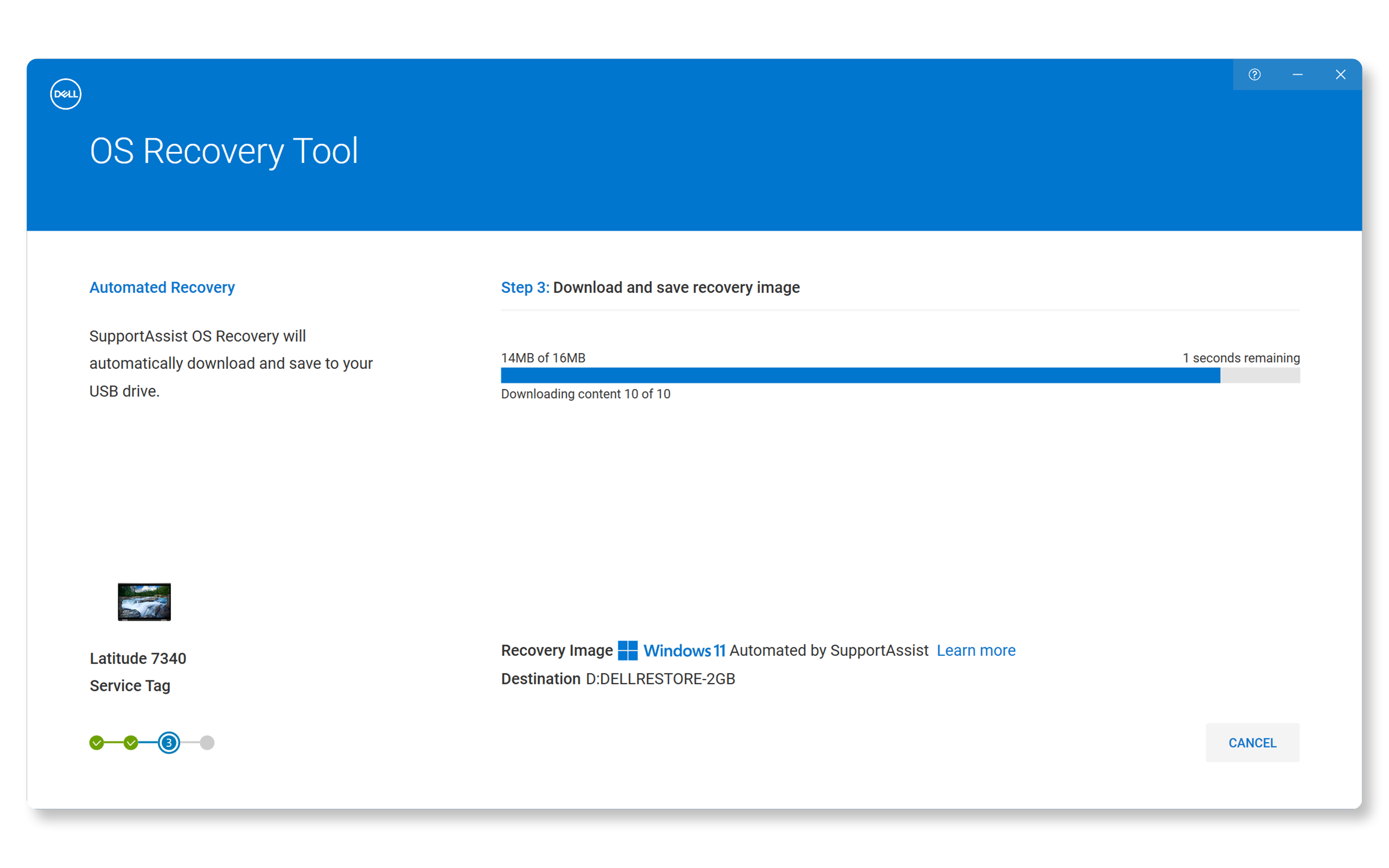Create an OS Recovery Image with the Dell OS Recovery Tool
Dell Technologies recommends using SupportAssist OS Recovery for the best experience when restoring supported computers. If you can’t use SupportAssist, follow the steps in this guide to make a USB recovery drive.
What is Dell OS Recovery Tool?
The Dell OS Recovery Tool helps you download a recovery image for your Dell computer. You can use this tool to make a USB recovery drive to bring your computer back to its original state.
If your computer can’t use Dell SupportAssist OS Recovery or it’s not available, you can get recovery images online. Use the Dell OS Recovery Tool to quickly download and create a bootable USB drive to reinstall the operating system.

What You Need
- A working Windows 10 or Windows 11 computer with .NET Framework 4.8 or newer.
- A USB drive with at least 16 GB of free space.
- Internet connection.
- Download and Install Dell OS Recovery Tool.
Why It’s Important
Creating a recovery image or recovery drive is crucial because it helps you:
- Restore your computer if it crashes or has serious issues.
- Save time by avoiding the need to reinstall everything from scratch.
- Protect your data by having a backup plan.
Step 1: Download and Install Dell OS Recovery Tool
The Dell OS Recovery Tool works on Windows 10 and Windows 11 with .NET Framework 4.8. You can only install it on x64 and ARM64 versions of Windows.
- Go to the Dell OS Recovery Tool page.
- Select the x64 or ARM64 version that matches your computer.
- Double-click the installer and follow the on-screen instructions to install the tool on your computer.

Step 2: Identify your Dell Computer
- Open the Dell OS Recovery Tool.
- Enter your computer’s Service Tag. If you're using the same Dell computer, it will be auto-detected. If you're using a different computer, you need to enter the Service Tag manually. You can find it on a sticker on your computer. If the Service Tag is not recognized, see FAQ #19 below.

Step 3: Prepare Your USB Drive
- Insert the USB drive into your computer.
- Choose the USB drive you inserted.
- Check the box to confirm that the USB drive will be erased and all data will be deleted.

Step 4: Create the Recovery Image
- Click Download to start downloading the recovery image.
- Wait for the download to complete. This might take some time depending on your internet speed.
- Once the download is complete, the tool will automatically create the recovery image on your USB drive.

Step 5: Use the Recovery Image
- Restart your computer.
- Press F12 when you see the Dell logo to enter the boot menu.
- Select the USB drive from the boot menu.
- Follow the on-screen instructions to restore your computer using the recovery image.
Tips for Using Dell OS Recovery Tool
- The process will erase all data on your USB drive. Back up any important files before starting.
- Keep your computer plugged in to avoid interruptions during the download and creation process.
- Use a wired internet connection for a more stable download.
Frequently Asked Questions
Here are some popular FAQs about the Dell OS Recovery Tool with detailed answers.
1: What do I need to create a recovery image using the Dell OS Recovery Tool?
- You will need a working Windows computer, a USB drive with at least 16 GB of free space, an internet connection, and the Dell OS Recovery Tool installed on your computer.
2: Will using Dell OS Recovery Tool erase all my data on the USB drive?
- Yes, creating a recovery image using the Dell OS Recovery Tool will erase all data on your USB drive. It is important to back up your files before creating the recovery image.
3: Can I use Dell OS Recovery Tool on a non-Dell computer?
- Yes, the Dell OS Recovery Tool can be used on another Windows computer to create a recovery image.
4: How long does it take to create a recovery image?
- The time it takes to create a recovery image depends on your internet speed and the size of the recovery image. It can take anywhere from a few minutes to several hours.
5: What should I do if the Dell OS Recovery Tool fails to create a recovery image?
- If the tool fails to create a recovery image, ensure that your USB drive is properly inserted and has enough free space.
- Check your internet connection and try restarting the tool.
- If the problem persists, you may need to contact Dell Support for further assistance.
6: Can I use the recovery image to install the operating system on a new hard drive?
- Yes, you can use the recovery image created with the Dell OS Recovery Tool to install the operating system on a new hard drive.
- Simply boot from the USB recovery drive and follow the on-screen instructions to install the OS.
7: What operating systems are supported by the Dell OS Recovery Tool?
- The Dell OS Recovery Tool works on Windows 10 and Windows 11 with .NET Framework 4.8. You can only install it on x64 and ARM64 versions of Windows.
- You cannot install Dell OS Recovery Tool on a mac or Linux computer.
8: Can I create a recovery image for Windows and Linux using Dell OS Recovery Tool?
- Yes, Dell OS Recovery Tool supports creating recovery image for the operating system that was preinstalled on your Dell computer, like Windows or Ubuntu.
9: How do I use the recovery image to restore my computer?
- To use the recovery image, restart your computer and press F12 when you see the Dell logo to enter the boot menu.
- Select the USB drive from the boot menu and follow the on-screen instructions to restore your computer using the recovery image.
- Restoring your computer with the recovery image will erase all your data. Make sure to back up your files before you start.
10: Can I use the Dell OS Recovery Tool on a mac or Linux computer?
- No, you can only install the Dell OS Recovery Tool on computers running Windows 10 or Windows 11.
- You also need to have Microsoft .Net Framework 4.8.1 or a newer version installed.
11: Can I create a recovery image without a USB drive?
- No, you need a USB drive with at least 16 GB of free space to create a recovery image using the Dell OS Recovery Tool. The USB drive is necessary to store the recovery image and to boot your computer for the recovery process.
12: What should I do if my USB drive is not recognized by the Dell OS Recovery Tool?
- If your USB drive is not recognized, try the following steps:
- Ensure the USB drive is properly inserted.
- Use a different USB port.
- Format the USB drive to FAT32 or NTFS.
- Try using a different USB drive.
13: Can I use the Dell OS Recovery Tool to upgrade my operating system?
- No, the Dell OS Recovery Tool is designed to create a recovery image for restoring your computer to its original factory state. It is not intended for upgrading your operating system.
14: What happens if my internet connection is interrupted during the download process?
- If your internet connection is interrupted, the download process will pause.
- Once the connection is restored, the download should resume automatically.
- If it does not, you may need to restart the Dell OS Recovery Tool and begin the download again.
15: Can I create multiple recovery images for different Dell computers using the same USB drive?
- No, each recovery image is specific to the Dell computer for which it was created. You will need a separate USB drive for each recovery image.
16: Can I use the Dell OS Recovery Tool to back up my personal files?
- No, the Dell OS Recovery Tool is designed to create a recovery image for restoring your operating system. It does not back up personal files. You should use a separate backup solution to save your personal data before using the recovery tool.
17: Can I use the Dell OS Recovery Tool for Linux-based systems?
- Yes, the tool supports creating recovery images for both Windows and Linux operating systems that were preinstalled on your Dell computer.
18: Can I use the Dell OS Recovery Tool to create a recovery image on a DVD?
- The Dell OS Recovery Tool is designed to create a recovery image on a USB drive, not a DVD. The tool specifically supports creating bootable USB recovery media, which is more reliable and faster than DVDs.
19: Why is my Service Tag not recognized by the Dell OS Recovery Tool?
- If your Service Tag is not recognized by the Dell OS Recovery Tool, there could be several reasons for this issue. Here are some common causes and solutions:
- Incorrect Service Tag: Double-check the Service Tag you entered. Ensure there are no typos and that you are using the correct combination of letters and numbers.
- Older Operating Systems: Recovery images are only available for supported systems with Windows 7 and newer versions.
- Internet Connection Issues: Ensure you have a stable internet connection. An unstable connection might prevent the tool from verifying the Service Tag.
- If none of these solutions work, it’s best to contact Dell Technical Support for further assistance.
20: Can I use the Dell OS Recovery Tool without a valid Service Tag?
- No, you cannot use the Dell OS Recovery Tool without a valid Service Tag. The tool requires a valid Service Tag to verify your device and provide the correct recovery image.
21: Can I create a recovery image for my Dell computer with Snapdragon?
- No, you cannot create a recovery image for your Dell computer with a Qualcomm Snapdragon processor using the Dell OS Recovery Tool.
- Use the Windows Push Button Reset on Qualcomm Snapdragon devices.